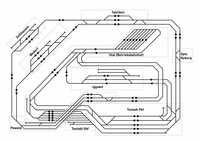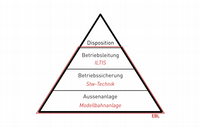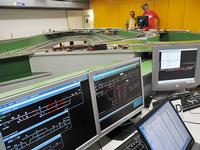|
|||||||||||
Railway operations laboratory (EBL)
Track plan
Overview
Railway system levels
Download
Leaflet (PDF 3.1MB)
Illustration (ZIP 7.9MB)
Contact
e-Mail: EBL-Inquiry
Functioning
In the railway operations laboratory (EBL), the individual levels of railway operations (planning, management, safety and external operations) and their relationships are clarified. The person being instructed can take over different functions (e.g. dispatcher, service manager etc.) in order to be able to understand the operational relationships from different angles through personal intervention. Here, the different signal box technologies are of particular importance. One can most clearly understand the safety philosophy when one looks at the older designs (particularly the mechanical designs), however the trainees can familiarize themselves with the basis of the electronic signal box with the user interface of the future.
With the
modernization of the plant in the years 2009/2010, the second highest
level, the operational control can now be investigated in EBL: The
installation of the control system ILTIS of Siemens Switzerland AG
means that almost all operating locations can be controlled by signal
boxes. The infrastructure has been extended to give an eight track
station Testadt which has a passenger and a freight station part.
The former terminal stations Pewald and Iggswil have now been
complemented by another station head and are connected to an eight
track staging station Utal. Further, vehicle control is implemented
and this provides the features of realistic vehicle dynamics
dependent on traction and train mass. Thus, for example, the
incorrect operation of the signal box by the operator would be
directly and vividly illustrated by the resulting delays.
Users
- Railway operating staff – in the training of operating staff it is particularly important to look at the correct use of safety systems, the handling of rules, scheduling and fault management in railway operations.
- Students with appropriate subject choice in the Department of Civil, Environmental and Geomatic Engineering at ETH Zurich – The focus of the students' education is on understanding the individual operating processes in the entire rail system. The student will thereby gain an understanding of the complexity of the system, together with its comprehensive safety philosophy.
- External trade visitors from companies which produce signaling and safety equipment.
Sponsorship
The following three project partners are responsible for the modernization and operation oft he facility:
- Siemens Schweiz AG
- Swiss Federal Railways AG
- Institut für Verkehrsplanung undTransportsysteme (IVT), ETH Zürich
In addition, the support of the following partners was won for the renovation:
- iRFP Dresden
- Signalhalle Steinen
History
- 1955
- First facility in the attic of the main building of ETH Zurich
- 1978/1980
- Commissioning in the new premises on the Hönggerberg in two stages
- 1991
- Modernization of model railway components due to heavy use and wear and tear
- 2009/2010
- Comprehensive modernization of the entire system and expansion of the signal box and vehicle control technology to include modern components.
Technical implementation and model railroading
The entire facility has an area of approximately 50m2 and includes 600m track and 7 stations. The track topology is shown in the schematic. In practice, the trains always make at least one circuit of the entire track before they go to the next station. Thus, the travel times between individual stations are artificially extended to simulate realistic conditions when operating in timetable mode.
As part of the command and control technology, all major signal box designs can be mapped: From the mechanical signal box (Iggswil) from the early years of railway safety engineering through the so-called "switch works" (Zetthausen) that embodies the collection of electrical impulses from the early 20th century, to ILTIS remote control technology which is now widespread in Switzerland, the EBL offers authentic workstations. The common relay technology from many decades is based on the Domino signal box design represented by (Do 67 - Ypslikon and Do 69 - Pewald) . The relay station Ypsilkon is based on original technology, which is located in a separate room next door, while due to the new modifications and extensions to the station Pewald, this is now controlled on the basis of SPS.
Iggswil IGG
- Through station
- 3 operating tracks
- Output station of a double-track line in the conventional left-hand traffic
- Mechanical signal box, type ,Bruchsal J'
- Semaphore/form signals
Station Zetthausen ZET
- Through station
- 2 platform tracks with access at a level, 1 ramp track (no entry possible)
- two-sided single tracks
- Electro-mechanical signal box
- Light signals type L
Station Pewald PEW
- Junction station
- 2 platform tracks, 1 interim platform
- one-sided double track line, output station of two single track lines with short bottleneck
- Domino 69 switchboard with simulated relay technology
- Light signals type L
Station Ypslikon YPS
- Junction station
- 3 platform tracks with rail-free access
- Transition from the double track section to two single track sections
- Stop Oberg with block 208/209 integrated in signal box Ypslikon
- Domino 67 switchboard with original relay technology
- Light signals type L (combined (block-) signals)
Station Wedorf WED
- Through station
- 3 platform tracks with rail-free access
- Two sided single tracks
- User interface of a remote Domino 67 switchboard control panel
- Light signals type L
Station Testadt TES
- Knot station
- 4 platform tracks with rail-free access
- Multi-track freight yard area
- Two sided double track section, as well as an exit station for a double track section in conventional left-hand traffic.
- Lane change Quburg integrated in signal box Testadt
- User interface of a remote Domino 67 switchboard control panel
- Light signals type N, control panel equipped on both sides with mini signals
Station Utal UTA
- 8-track staging yard
- Automated control of the trains from the access routes to Pewald, Testadt and Iggswil according to the filed schedule
ILTIS-workstation
- Optional remote control of the signal boxes of Testadt, Ypslikon, Pewald, Wedorf and area overview of Zetthausen control system based on Siemens 'ILTIS'
- Interventions in network sections possible
Wichtiger Hinweis:
Diese Website wird in älteren Versionen von Netscape ohne
graphische Elemente dargestellt. Die Funktionalität der
Website ist aber trotzdem gewährleistet. Wenn Sie diese
Website regelmässig benutzen, empfehlen wir Ihnen, auf
Ihrem Computer einen aktuellen Browser zu installieren. Weitere
Informationen finden Sie auf
folgender
Seite.
Important Note:
The content in this site is accessible to any browser or
Internet device, however, some graphics will display correctly
only in the newer versions of Netscape. To get the most out of
our site we suggest you upgrade to a newer browser.
More
information






